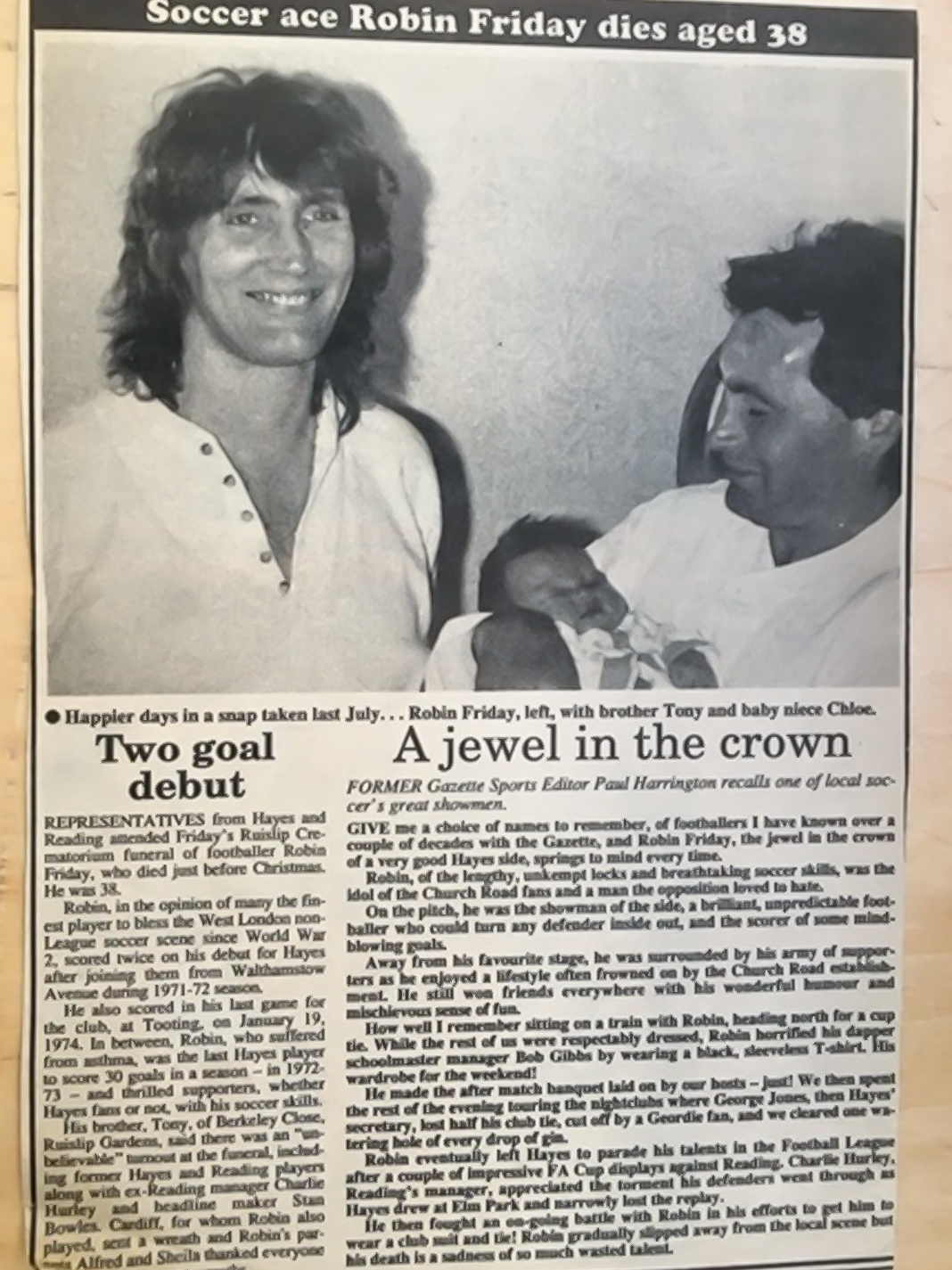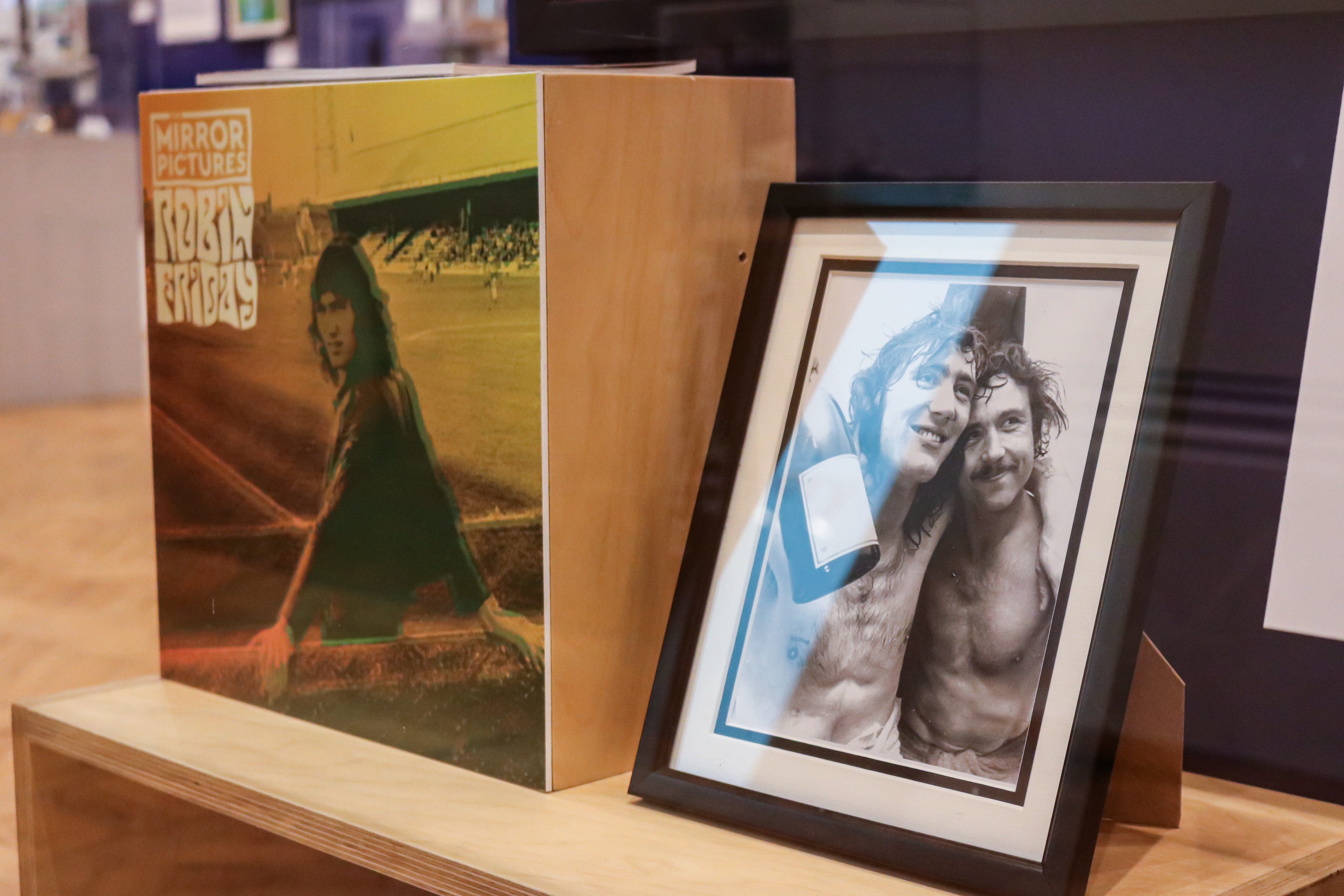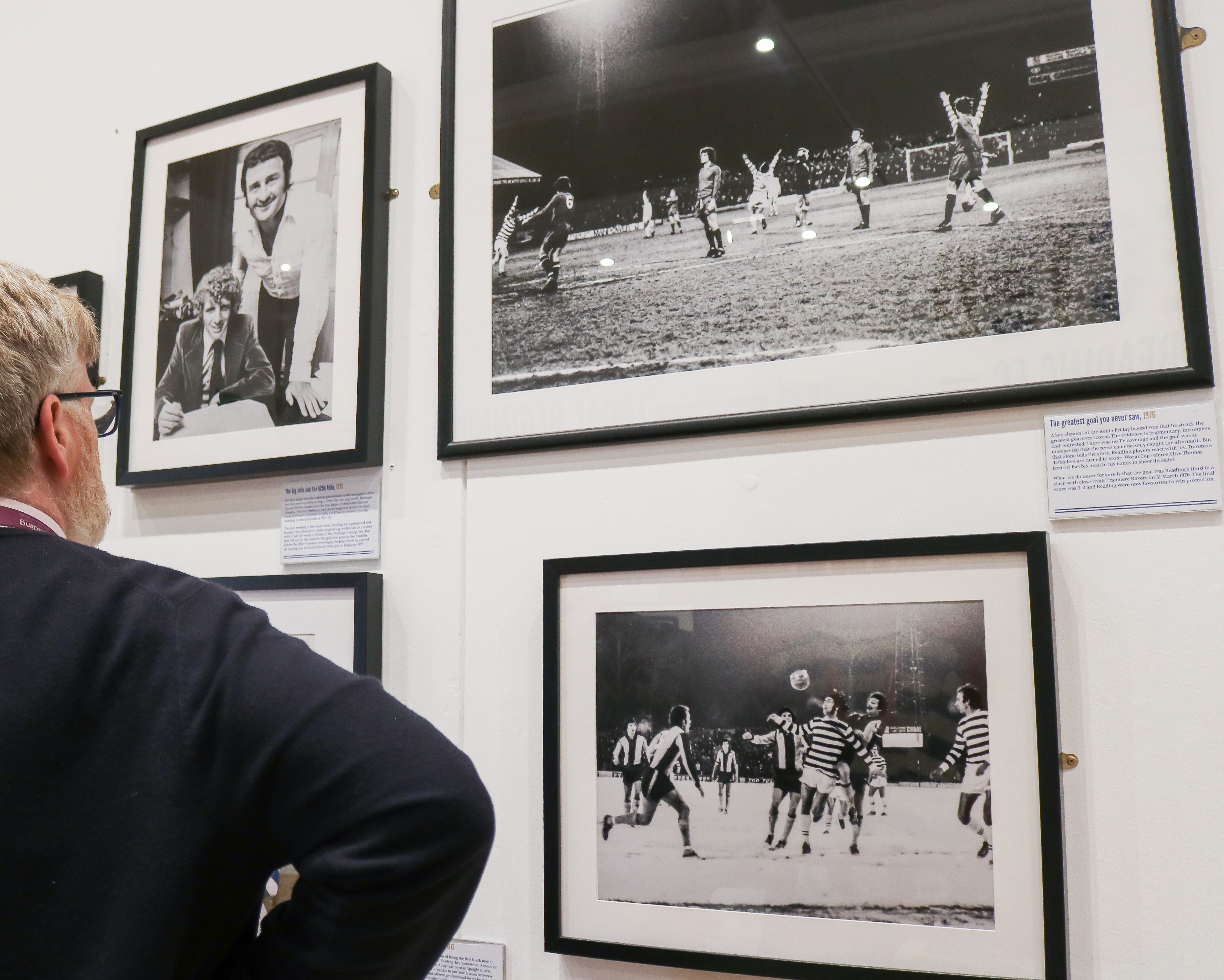Join author Stuart Kane as he reflects on a visit our Reading FC anniversary exhibition, and explores highlights from the legendary career of the iconic Royal, Robin Friday: the greatest footballer you never saw.
My name is Stuart Kane, and I am the author of two fact-based novels about Robin Friday called Man Friday: The First Half and Man Friday: The Second Half. I have a fondness for Reading as it’s where my grandfather was born in 1920 from a marriage between the Lawrence and Stonehill families.
On Saturday 9th April 2022, I visited Reading Museum to meet with Brendan Carr, the museum’s Community Engagement Curator. Brendan has put together a fantastic exhibition which celebrates the 150th anniversary of Reading Football Club. Amongst the memorabilia on display is a jersey and photographs of an extraordinary Reading hero: the late, great Robin Friday.
Below, join me for a snippet of what I saw some and some insights into my day. From a behind the scenes look at the exhibition, to meeting Robin's family. I'll also share some of the most very special moments from Robin's time as a Reading player. His mercurial footballing skill and the legacy of his time at the Club continues to capture our imaginations today.
Robin Friday and a lucky policeman
The first photograph that Brendan showed to me is the original press photograph of Robin Friday kissing a policeman.
Reading were up against Rochdale at Elm Park on the evening of Wednesday 9 April 1975, precisely forty-seven years before the day of my visit to the museum. I have been told there was always something special about midweek games at Elm Park under those floodlights. There was a magic. And Robin Friday was very much part of it.
Rochdale took the lead early on, and Andy Alleyne had equalised for Reading with a header with about fifteen minutes to go. With the score level at 1-1 and the final whistle looming, Robin Friday pounced onto a deflection off the Rochdale keeper and stroked the ball into the back of the net from five yards out.
Amidst the celebrations, Robin ran behind the goal, spotted a lonely policeman, and gave him a big kiss. Robin said, ‘On the spur of the moment, I grabbed him and gave him a kiss. The funny thing was he kissed me back!’
We can see another Reading player in the photograph. David Downs, Reading FC Club Historian, reliably informs me it is John Ashton, who looks delighted to be part of the celebrations. Perhaps he got a kiss too! The photographer beautifully captured this special moment. And this was an unlikely pairing, given that Robin was not much of a fan of the ‘Old Bill’.
‘Oi, that’s my goal!’
On the back of this sequence of photographs is written: ‘RDG v CREWE 24/4/76’.
At the time of this match, Reading had already been promoted. It was meant to be a TV spectacular, but it was not, as Crewe had come to frustrate. I have seen these photographs many times before, particularly the last one. But I had never realised they were part of a sequence.
In the first frame, we see Robin mid-flight, latching onto a Ray Hiron cross between two defenders, and sending the ball towards the goal from a tight angle.
Robin watches the ball in the second shot, as it nears the goal line. We see Gordon Cumming baring down upon it.
In the final photo, we see Robin punching the air and running towards the crowd. You can see The Spread Eagle in the background, one of Robin’s haunts.
Robin and Gordon argued over that goal. Cumming believed he had put the ball over the line, but Robin wasn’t having any of it! The goal was awarded to Robin, bringing his tally to twenty-two goals in that promotion-winning season of 1975/76. Twenty goals had been his target for the season.
Mrs Friday’s MR MEN scrapbooks
When Brendan showed me the two scrapbooks, I felt the hairs on the back of my neck stand up. They're so very 70s. On the cover, we have Mr Silly, is sporting a pair of boxing gloves and a huge smile. Ready for a scrap, no doubt!
If you're wondering about these books' relation to Robin, it's because they were put together by Robin’s mum, Sheila. They chart Robin's footballing history and his life.
The scrapbooks show it all. There is no hiding from the trickier headlines. They lovingly and meticulously chart Robin’s story and poignantly show a mother’s love for her son.
There's a line from the Roger Hargreaves book about Mr Silly, which is, I recall, ‘Mr Silly had never won the Cup, but each night, lying in his bed, he dreamed about winning it.’ It doesn’t take too much of a leap of imagination to picture a young Robin Friday dreaming of winning the FA Cup at Wembley.
Robin could sometimes be Mr Silly, but he could be Mr Quiet too, and Mr Happy, Mr Funny, Mr Bump, Mr Bounce, and a few more to boot. Robin Friday was indeed a complex character, as well as an exceptionally gifted footballer.
Shine on, shine on...
On the last page of the second Mr Men scrapbook, the final entry is not stuck in. It comes away loose as I open it. Its title reads ‘Soccer ace Robin Friday dies aged 38’. It contains two beautiful, genuinely heartfelt write-ups about Robin and his life.

I've seen this photograph of Robin before, but the microfiche version that I have looked at previously does not have the same level of detail or clarity. The picture was taken in July 1990. We see a beaming Robin with his baby niece Chloe and Chloe’s very proud dad, Tony. Tony was Robin’s twin brother. It's a beautiful photograph, and the smiles and the pride leap from the page. It captures a special family moment. Later that year, Robin would sadly be gone.
Meeting the Friday family
Poignantly, I was to meet up with Tony, Chloe, and Tony’s grandson Teddy at Reading Museum as we visited the exhibition. Later that day, they would be attending the Reading vs Cardiff City match as guests of honour, a match that is sometimes known as ‘The Robin Friday derby’. It was lovely to meet them.
As we first made our way into the museum galleries, we saw the sign of the Boar’s Head pub. Made from limestone, a post-medieval object, it must have seen thousands of patrons pass beneath its gaze. We each acknowledge that Robin would have walked under that sign many times on his adventures. There are knowing smiles. If only that Boar’s head could talk. It would have some stories of Reading's past to tell.
We climb the stairs to the fittingly-named The Sir John Madejski Art Gallery and enter the Reading FC exhibition. It is all blue and white, and I can’t help but think of the chant: ‘CHARLIE HURLEY’S BLUE AND WHITE ARMY!’
We see Robin’s jersey worn in the 1975/76 season opener against Rochdale and sporting the number eleven, which became Robin’s training top. Tony’s eyes light up. There's a photograph of Robin and Brian Carnaby celebrating together after winning promotion at Cambridge United. The two goalscorers pose with smiles as big as the magnum of champagne in Robin's hand.

Next, we see a photograph of Robin, sporting his Andy Capp forearm tattoo, and his autograph. This is another photo I haven’t seen before. Then behind us, we spot Robin in the Reading FC 1974/75 team photograph. In this, he has a serious look as if he means business. And it was a season in which business was duly delivered, as he ended the 74/75 season as Reading’s player of the year and top goalscorer with a tally of eighteen goals.

Another photo shows arguably Robin’s most spectacular moment, that wondergoal versus Tranmere Rovers. I point at Robin in the picture. He is obscured from view, hidden behind a Tranmere defender with his arms raised in celebration. Clive Thomas’s hands are on his head in pure disbelief, and the Tranmere defenders are stuck still like a row of table football players.
This was Robin’s special moment, and that goal helped cement his name into footballing folklore. To the left, there's a photograph of Charlie Hurley signing Eamon Dunphy, Robin’s friend and former teammate. Charlie beams down at us with his film star smile.

Finally, we catch another image of Robin, playing his very last game for Reading away at Oxford United before transferring to Cardiff City (the bottom photograph in the image above). Tony reads the title on the photograph: ‘A sad and surreal farewell to a legend, 1976’. I read the description: ‘The pitch was snow white, the touchlines were painted blue, the ball was orange, the temperature was freezing, the Bovril ran out at half-time, and we lost one-nil, the last minute. Friday signed for Cardiff the next day’.
I think of Robin playing his very last game and of how those Reading fans must have felt, as word got around of his imminent departure...
Continue reading with part two
On a magnificent day of footballing history, keep reading as Stuart reflects on watching the Reading vs Cardiff game alongside the Friday family!
Find out more about our Reading FC anniversary exhibition and plan your free visit to the museum. Alternatively, explore more stories on our blog about Reading FC history, such as an exploration of the Club's earliest days.





